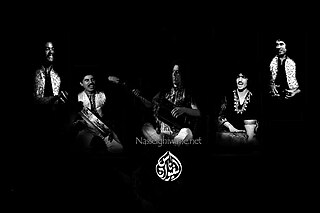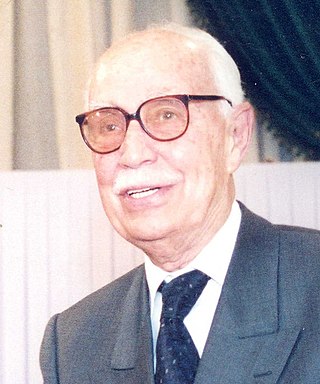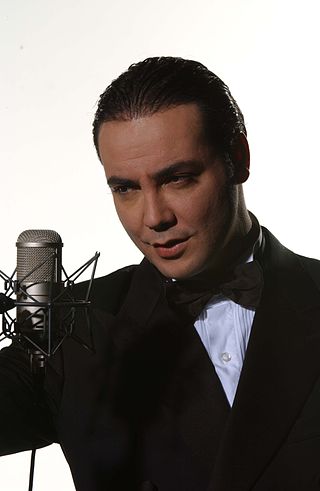
Cinema Vox was a 20th-century movie theater in Casablanca, Morocco. [1] [2] It was designed by Marius Boyer and completed in 1935, under the French Protectorate. [1] It was considered one of the largest movie theaters in Africa. [1]

Cinema Vox was a 20th-century movie theater in Casablanca, Morocco. [1] [2] It was designed by Marius Boyer and completed in 1935, under the French Protectorate. [1] It was considered one of the largest movie theaters in Africa. [1]
It had three stacked balconies and could seat up to 2,000 spectators. [1] It also had a foldaway ceiling, allowing the audience to enjoy the cool air of the evening. [1] The building had the shape of a "cubic mass," which matched the Magasins Paris-Maroc Building next-door. [1] The architecture of the Vox continued to serve as a reference for movie theaters built after independence. [1]
It was located at Louis Gentil Square, now part of United Nations Square. [1]
Nass El Ghiwane had a breakthrough concert at Cinema Vox. [3]

Casablanca is the largest city in Morocco and the country's economic and business centre. Located on the Atlantic coast of the Chaouia plain in the central-western part of Morocco, the city has a population of about 3.71 million in the urban area, and over 4.27 million in Greater Casablanca, making it the most populous city in the Maghreb region, and the eighth-largest in the Arab world.

Nass El Ghiwane are a musical group established in 1970 in Casablanca, Morocco. The group, which originated in avant-garde political theater, has played an influential role in Moroccan chaabi.

The culture of Morocco is a blend of Arab, Berber, Andalusi cultures, with Mediterranean, Hebraic and African influences. It represents and is shaped by a convergence of influences throughout history. This sphere may include, among others, the fields of personal or collective behaviors, language, customs, knowledge, beliefs, arts, legislation, gastronomy, music, poetry, architecture, etc. While Morocco started to be stably predominantly Sunni Muslim starting from 9th–10th century AD, during the Almoravid period, a very significant Andalusi culture was imported, contributing to the shaping of Moroccan culture. Another major influx of Andalusi culture was brought by Andalusis with them following their expulsion from Al-Andalus to North Africa after the Reconquista. In antiquity, starting from the second century A.D and up to the seventh, a rural Donatist Christianity was present, along an urban still-in-the-making Roman Catholicism. All of the cultural super strata tend to rely on a multi-millennial aboriginal Berber substratum still present and dating back to prehistoric times.
Laarbi Batma was a Moroccan musician, poet, singer, writer, actor, and the front man of the group Nass El Ghiwane.
Jil Jilala is a Moroccan musical group which rose to prominence in the 1970s among the movement created by Nass El Ghiwane and Lem Chaheb. Jil Jilala was founded in Marrakech in 1972 by performing arts students Mohamed Derhem, Moulay Tahar Asbahani, Sakina Safadi, Mahmoud Essaadi, Hamid Zoughi and Moulay Abdelaziz Tahiri. In 1974, they released their first record Lyam Tnadi on the Atlassiphone label. The songs "Leklam Lemrassaa," "Baba Maktoubi," "Ha L'ar a Bouya," "ah ya Jilala" and "Chamaa" quickly achieved the status of popular 'classics.'

The history of the city of Casablanca in Morocco has been one of many political and cultural changes. At different times it has been governed by Berber, Roman, Arab, Portuguese, Spanish, French, British, and Moroccan regimes. It has had an important position in the region as a port city, making it valuable to a series of conquerors during its early history.

Cinema of Morocco refers to the film industry of Morocco. Aside from Arabic-language films, Moroccan cinema also produces Tamazight-language films. The first film in Morocco was shot by Louis Lumière in 1897. The first three Moroccan feature films were funded between 1968-1969. Most researchers and critics agree that the history of Moroccan cinema started with Hamid Bénani's Wechma (1970), which is recognised as the first cult movie in Moroccan film history, and received critical acclaim on an international scale. Until then films produced in the country were Moroccanised versions of Egyptian melodramas. Other influential Moroccan films include A Thousand and One Hands, which was the first feature length fiction film of the 1970s.
The World Cinema Project (WCP), formerly World Cinema Foundation, is a non-profit organization devoted to the preservation and restoration of neglected world cinema, founded by Martin Scorsese.

Abdelkrim Ghallab was a Moroccan political journalist, cultural commentator, and novelist. He is an important figure both in the literary and political field.
His Excellency Belyout Bouchentouf was a prominent businessman, statesman and philanthropist from the Kingdom of Morocco. Born in Casablanca at the turn of the 20th century, he left a lasting legacy in the capital and the Kingdom.
All I Wanna Do is a 2011 Moroccan documentary film produced by La Prod and directed by Michelle Medina starring Omar Sayed Nass El Ghiwane and Don Bigg, Simohamed, a parking guard and his 17-year-old son, Ayoub. The documentary was shot on location in Casablanca, Morocco from 2009 to 2010 and has won a documentary prize at the 2011 Athens International Film Festival and was nominated at the 2011 Aljazeera International Documentary Film Festival for "Best Film" and "Best Director" at the 2011 World Music and Independent Film Festival in Washington, DC.

Abdou Cherif was a Moroccan singer.

Dounia Batma is a Moroccan singer and actress who rose to popularity around the world as the runner-up of the first season of Arab Idol on MBC. She lost the title against Egyptian contestant Carmen Suleiman. She married Mohamed Al Turk, the father of Bahraini singer Hala Al Turk.
Hay Mohammadi or Hay Mohammedi is a neighbourhood in eastern Casablanca, in the Aïn Sebaâ - Hay Mohammadi district of the Casablanca-Settat region of Morocco. As of 2004 it had 156,501 inhabitants.
The following is a timeline of the history of the city of Casablanca, Morocco.
Trances is a 1981 documentary film about the influential Moroccan avant-pop band Nass El Ghiwane. It was shot, written, and directed by Ahmed El Maanouni.

Cinema Rialto is a movie theater built in 1929 in Casablanca, Morocco. It is one of the oldest cinemas in Morocco.
The Wilaya Building is the building that houses the administration of Grand Casablanca. It was designed by Marius Boyer and built from 1928-1937 during the French Protectorate in Morocco. The building is located at Muhammad V Square in central Casablanca, Morocco, and it remains an emblematic building of the city's architecture.

The architecture of Casablanca is diverse and historically significant. Casablanca, Morocco's economic capital, has a rich urban history and is home to many notable buildings in a variety of styles. Throughout the 20th century, architecture and urban development in Casablanca evolved in a way that was simultaneously specific to the city's contexts, and consonant with international ideas.
Marius Germinal Boyer was a French architect active in Casablanca, Morocco.
{{cite book}}: |last= has generic name (help)CS1 maint: multiple names: authors list (link)